#anyway. polish-american churches for the win
Explore tagged Tumblr posts
Text
Dresden Files ep 4:
opens with Harry getting visibly poleaxed by Sight of Pretty Woman. accurate characterization.
Morgan!!!
burned corpse + brimstone + "hey, what's this pattern on his hand?"
me: "DENARIANS?"
Harry is VERY rattled by a "demonic activity" case
The worldbuilding seems generally weaker and more SPNish in their approach to "hellions," but what can you expect (especially if Michael's not here. This kind of thing isn't even supposed to be on the Council's radar, it's the Church's turf)
This enemy is ALSO treading on vampire territory. You can't all run extremely shady nightclubs, man.
I do like his actor's performance, though. very mafia.
It has taken me FAR too long to register Harry does have a wand and a staff, it's just one of them is a drumstick and the other is a hockey stick. That's hilarious actually. The DIY wizardry continues.
OOH a pretty church!!
EMBARRASSING: Catholic reader born in Cook County is only just now looking up St. Mary of the Angels from the books. Verdict is that I am of course most partial to St. John Cantius, of the Chicago churches, but St. Mary's is GORGEOUS.
The church shown briefly in the TV show, however, is called St. Margaret of the Roses, and I cannot figure out its IRL location. But it IS pretty.
There is also a nun here. You know, like every Catholic church has nebulously attached to it somehow. It's fine though she didn't say anything dumb.
(Back to the plot) I KNEW this kid looked too much like a Milo Ventimiglia character to be evil.
He is, instead, discount Thomas. Fair enough.
This Morgan is WAY more laid back than his counterpart.
Ghost!Bob is a sap. No one is allowed to know it though.
11 notes
·
View notes
Text
Days 161-162: Munich
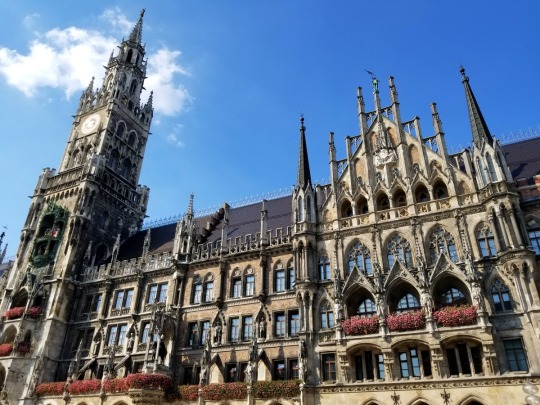
Two days after our brief dip into Germany, we dove in for good. Or for a couple weeks, at least.
Once again, we made it to our train with time to spare, but we had to split up anyway because almost all of the seats were reserved. Luckily it wasn’t a very long ride (less than two hours), but we vowed--not for the first or last time--to definitely get reserved seats for all of our long-haul rides in the future (spoiler: we didn't).

Our arrival in Munich went perfectly. We weren’t in any hurry, the weather was nice, we got some tasty sandwiches from one of the many appetizing eateries in the station, and when we found a ticket machine to buy our local transit passes, a couple stopped us and gave us their day pass that they didn’t need anymore. It was only good for the rest of that day, but definitely added to the day’s positive vibes.
We found our tram right where it was supposed to be, and half an hour later we were checked into our flat. It isn’t huge, but it’s much bigger than in Prague or Salzburg, and it’s below ground level. Meaning that it stays nice and cool during the daytime.
Not that we’ll be staying home all that much. We have a lot planned for our week in Munich, and we’re looking forward to all of it.
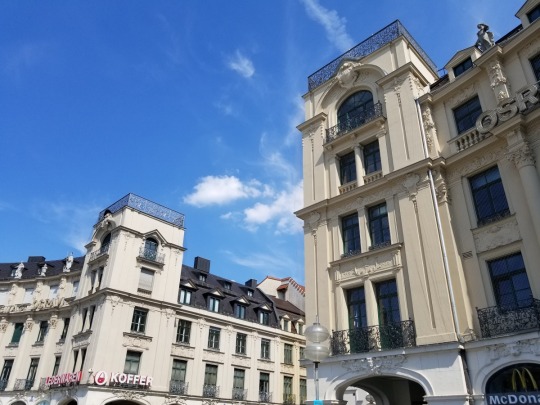
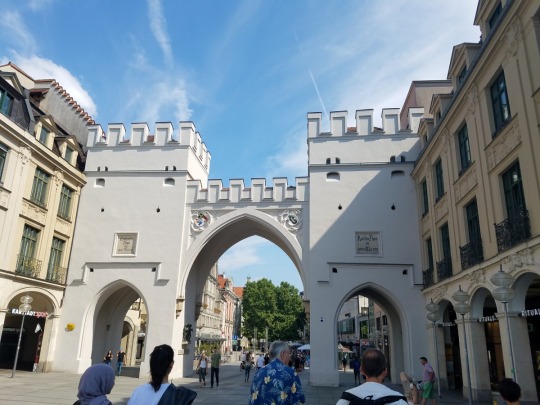
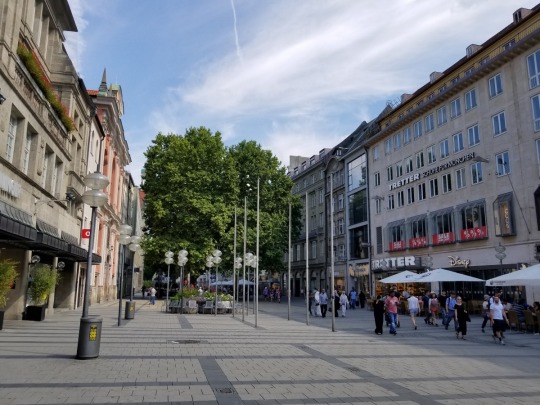
With most of the afternoon still ahead of us--and a free transit pass in our pockets--we decided to head back into town and wander about. We would need to head that way anyway if we wanted anything for dinner, since all the supermarkets in our suburb were closed for Sunday.
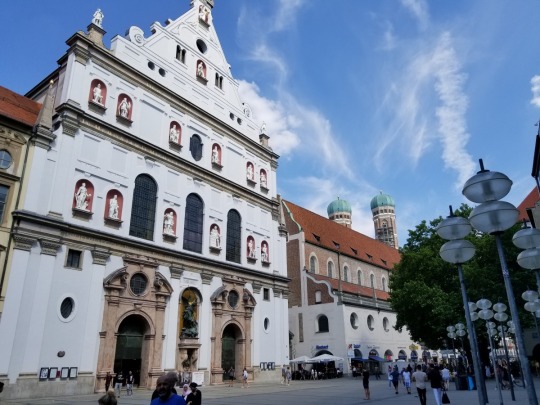

Munich suffered horribly during World War II. Almost all of the city center was damaged or destroyed by Allied bombing. But afterwards, the city worked hard to rebuild itself as closely as possible to what it had been before the bombs fell.
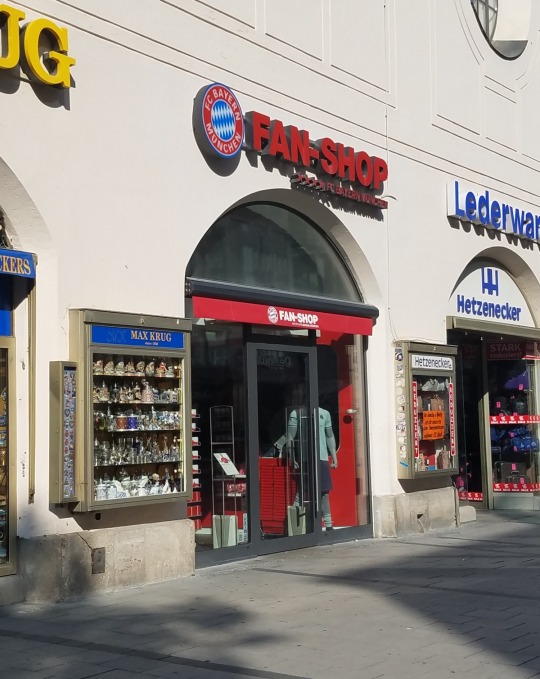
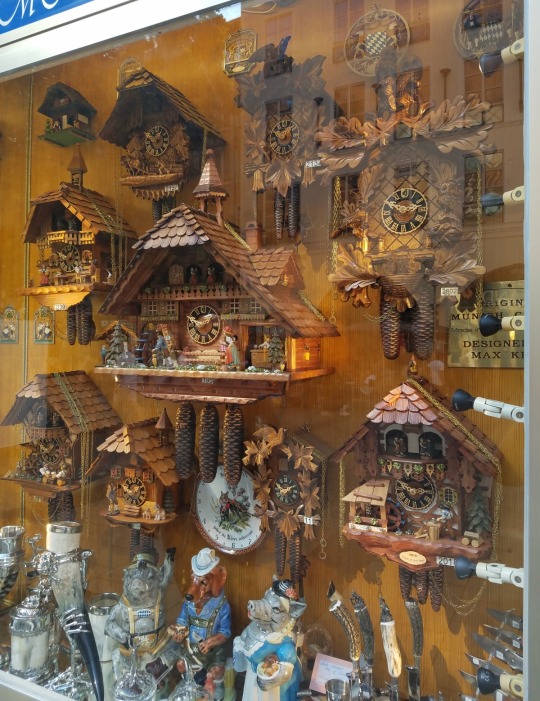
Jessica of course noticed the Bayern Munich FC store, and we found a display window full of cuckoo clocks. (I should clarify that Jessica is not a Bayern Munich fan; she roots for Dortmund in the Bundesliga.)
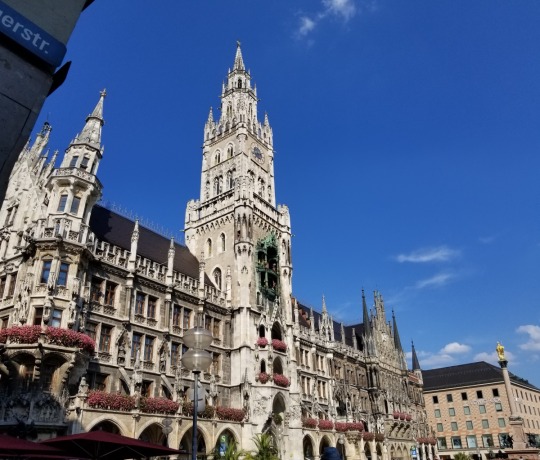

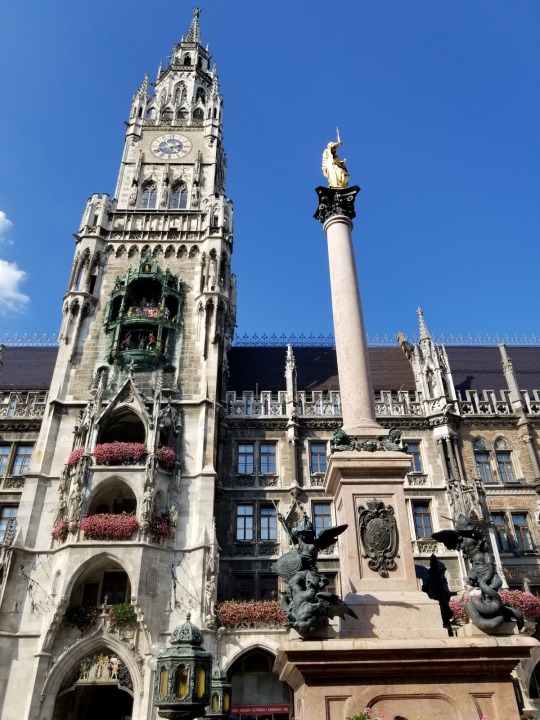
After stopping for some rest and refreshment at a street-side café, we continued on to Marienplaz, the square that has served as the historic heart of Munich for the past thousand years. It is named for the Virgin Mary, and a brilliantly polished gold statue of Mary stands at its center. Along the entire north side of the square is the spectacular Neo-Gothic New Town Hall, which was built in the late 1800s.

In one corner of the square is a fountain with a giant fish on it. We learned later that although this fountain was made after WWII, there has been a fountain in this spot since the 1300s, and the local fishmongers would actually keep their fish in it during market days.
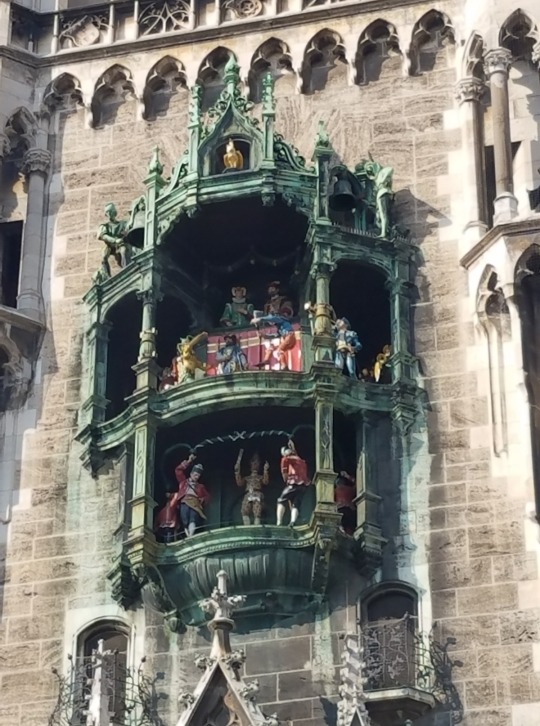
By pure chance, we arrived just before 5:00 pm, when the New Town Hall’s bell tower glockenspiel show performs every afternoon. The performance lasts around ten minutes and includes bell chimes and dozens of revolving figures. They dance, joust, and feast in celebration of a real-life wedding that took place in Marienplaz in the 1500s.
(Also, Jessica and I still can’t help but be amused that the German word for town hall is Rathaus.)
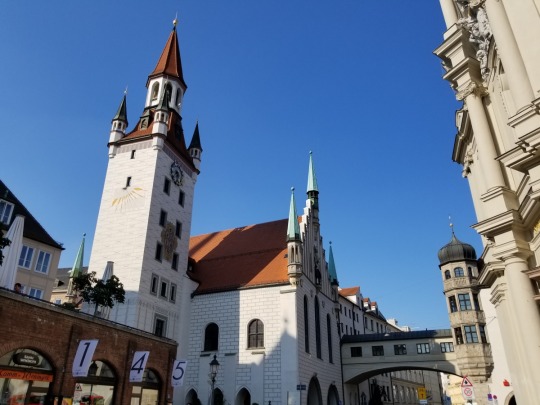
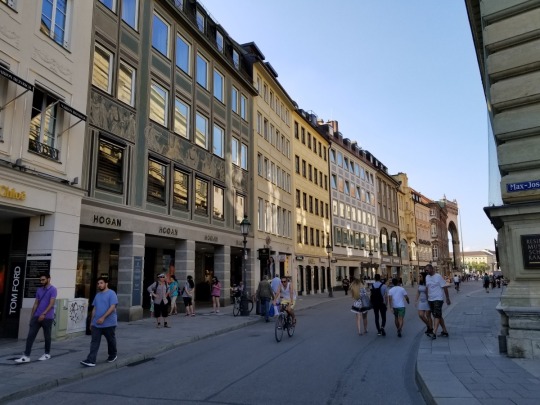
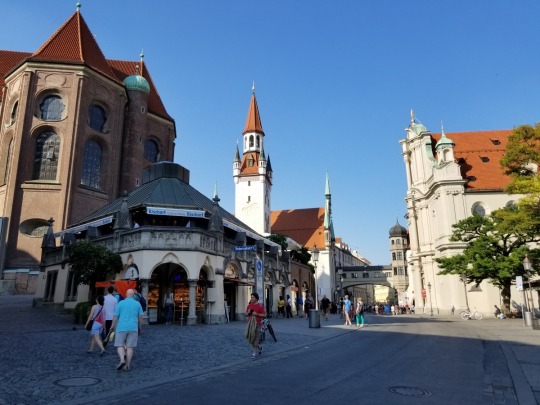
Once the show was over, we simply walked around the old town for a little while longer. We saw some charming window displays in closed shops, the closed up food market, and the Old Town Hall. Even though pretty much everything was closed for Sunday, there was an intoxicatingly pleasant atmosphere about the place. And it wasn't just the beer everyone was drinking, or even that it was the coolest afternoon we’ve experienced since leaving Scotland.
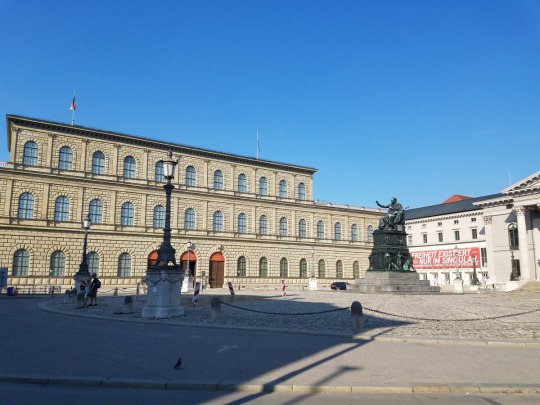
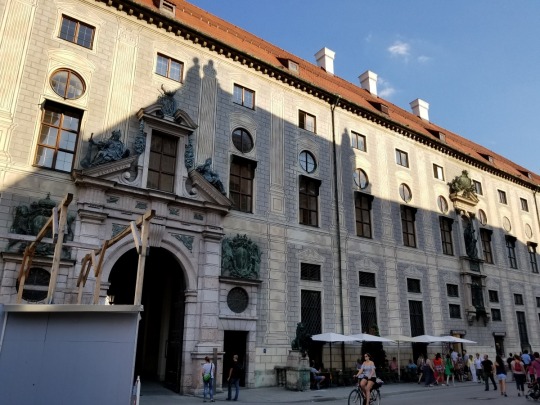
Our wanderings eventually took us to the Munich National Theatre and Royal Residence, which gets to be called a royal residence because Bavaria was technically a kingdom for about a hundred years out of its much longer history as a German duchy and principality.

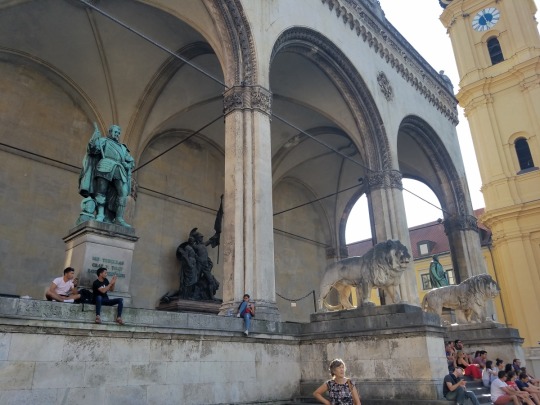
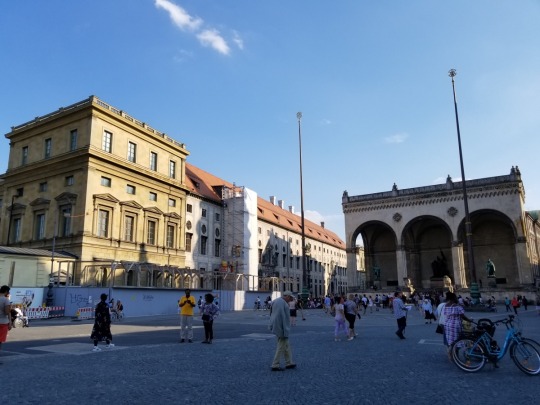
Between the Residence and the impressively yellow Theatrine Church is the Odeonsplatz, which was easy for us to remember because Odeon is also the name of major chain of movie theaters in the UK. The square also held a massive, statue-filled arcade--similar to the loggia in Florence. We would learn the next day that this was very much intentional and that Munich has even been called the Florence of the north.
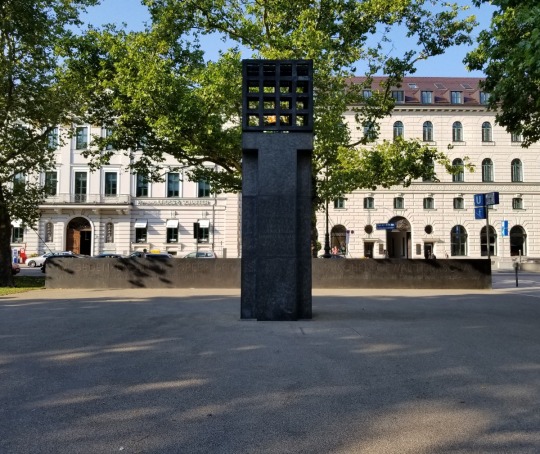
As we wound our way back toward the train station to catch a tram home, we discovered a stark stone column topped with an eternal flame. After translating the inscriptions, we learned that it is a monument to the victims of Nazi tyranny.
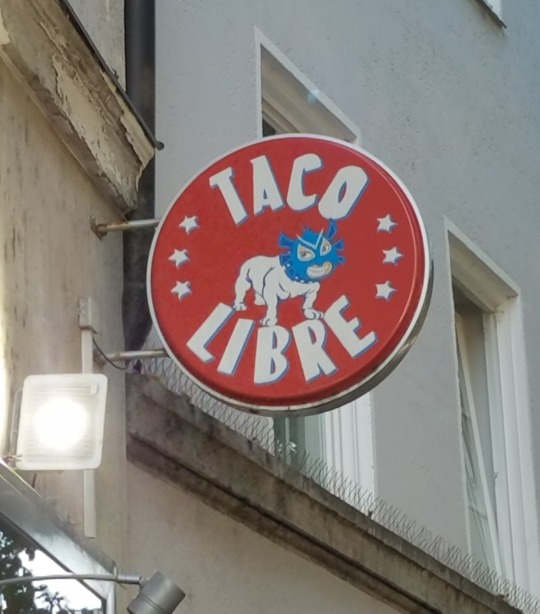
We also found an interesting-looking Mexican restaurant, but for some reason Jessica wasn't interested. We were tired, hungry, and in need of a bathroom, so we pressed on in search of a grocery store
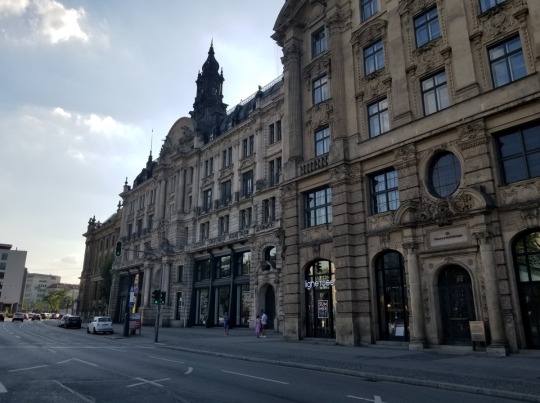
After way too long of a search in and around the central train station, we found the grocery store in the underground level connecting it to the city metro. It might have been the only one in the entire area that was open on Sunday afternoons, because it seemed like the entire city was standing in the checkout line. Seriously, the queue wrapped almost the entire way around the store and back to the entrance.
But the line moved surprisingly fast, and soon enough we were back home for a nice relaxing evening. Tomorrow, we would enjoy a guided walk through the city so that we could learn what everything we saw actually was. And we’d get to actually go into all the cool-looking shops that had been closed that day.
The next morning, we met up with our walking tour at the train station--again after a bit of slightly lost wandering. This was the first of several tours we'd booked with Radius Tours, one of two similar groups that Rick Steves recommends. We had a great time and would recommend them to anyone interested in good walking tours of Munich and nearby transit-accessible destinations like Dachau and Nuremberg.
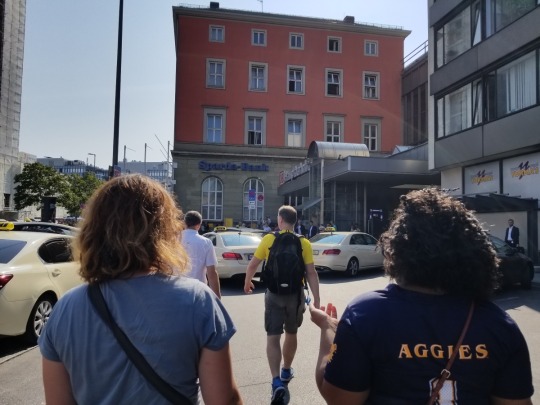
Our tour guide was an Irish man with a golden tongue. It may just be selection bias, but almost every Irish guide we met in Europe was a natural storyteller and crowd-wrangler. There was another American woman in out tour group, and she and Jessica were instant friends.
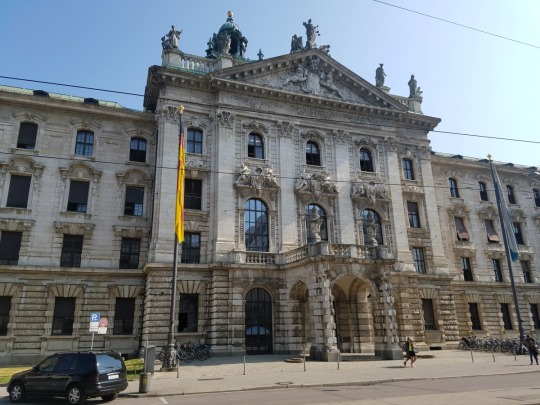
Just outside the train station, our guide pointed out a courthouse known as the Justice Palace. It still functions as a German district court, but it is most famous as the location of the White Rose trials during WWII, in which anti-Nazi student protestors were arrested and sentenced to imprisonment or death. The trials were conducted by "People's Courts," which Hitler had empowered to condemn enemies of the regime outside the normal judicial process and without regard for constitutional rights.
The execution of peacefully protesting German students without a fair trial sent shockwaves throughout Germany and the rest of Europe. It didn't lead to any open revolts within Germany, but it was noted that people were much less inclined to report student protestors to the Gestapo after the White Rose trials took place.
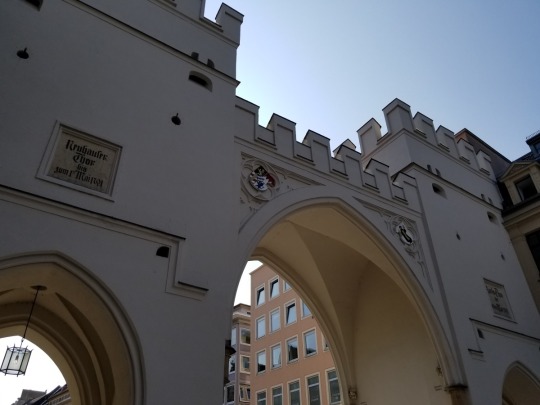
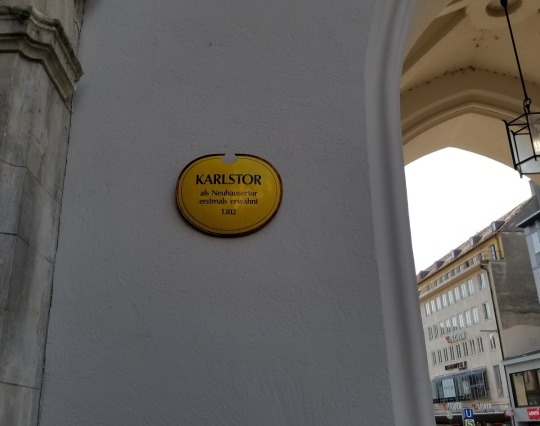
Before heading into the Old Town, we stopped for a few minutes to admire the Karlstor, one of the city's original medieval gates. Back in the day, this was the edge of a walled city surrounded by a moat. A shiny plaque proudly dates the gate to 1302, but the current structure is far younger than that. Much of the gate was destroyed in an accidental gunpowder explosion in 1857, and the subsequently restored gate has been heavily modified in the years since to accommodate increasing levels of street and pedestrian traffic.
Thanks to the 1972 Olympics, however, Munich's Old Town is now almost entirely pedestrianized.

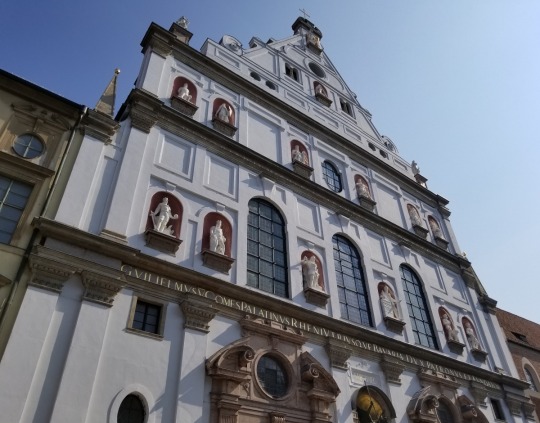
As we walked down the bustling Neuhauser Strasse from the gate to the central square, our guide pointed out the beautiful Baroque church façade we'd seen yesterday and identified it as St. Michael's, a Jesuit church. It was an important and influential church during the Counter Reformation, but today it seems mainly known for being under perpetual renovation since it was badly damaged during WWII.
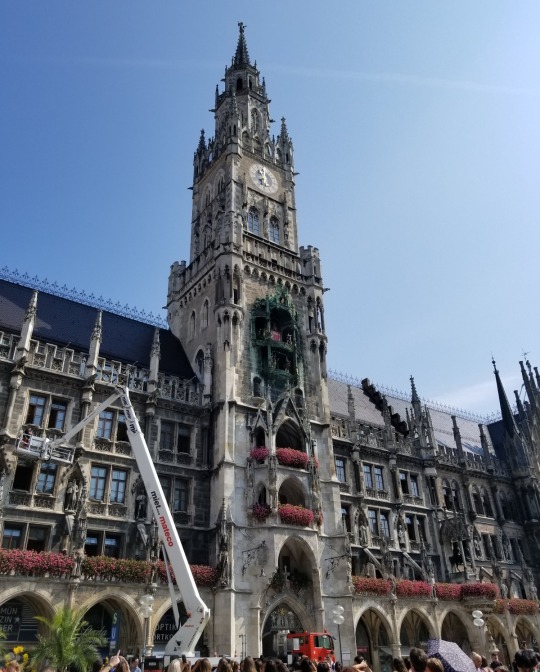
We reached Marienplatz just in time to catch the morning performance of the Glockenspiel. Our guide explained that the moving figures are actually references to two different stories in Munich's history. The top level shows a joust that took place at the wedding of Duke William V of Bavaria--the man who founded the Hofbrau as the official court brewery--to Renata of Lorraine. One of the knights is wearing Bavarian colors, and the other is wearing the colors of Lorraine (or Lothringen, as it's called in Germany). The Bavarian knight always wins.

The lower tier of the display tells another story that takes place a few decades earlier during a plague year. When the city was gripped by fear and discontent, the coopers' guild got together and danced through the city to raise people's spirits and show their support for the duke. The "Coopers' Dance" has since become a symbol of perseverance and loyalty.
And as small as all of these figures look from from down in the square, all of the figures are actually life-sized.
We also learned that the New Town Hall was one of the few buildings that wasn't destroyed by the WWII bombings. Ironically, this means that the New Town Hall is actually far older than the Old Town Hall, which had to be rebuilt after the war.

We saw Munich Cathedral, also known as the Frauenkirche, which is visible from around the city with its distinctive bronze-domed bell towers. We learned that when the cathedral was constructed in the Middle Ages, Munich was just a small market town in the shadow of its much older and wealthier neighbor Freising. Over time--and thanks to some political shenanigans--Freising gradually fell under Munich's growing shadow, and today it is chiefly known as the home of Munich International Airport.
But in the 15th century, that was all still to come. Munich wasn't wealthy, so the cathedral had to be built out of bricks instead of stone. The cathedral's one extravagance was to be a pair of massive bell towers topped with sky-scrapping spires. But even that proved too much, and the builders ran out of money. So instead, they capped the bell towers with simple bronze domes to keep out the rain, and they have stood thus ever since.
As an aside, the name Frauenkirche literally translates as “Church of Our Lady,” exactly the same as the many Notre Dames scattered across France.
It was around this time that I noticed I'd somehow put my shirt on backwards that morning, and for the rest of the tour my mind was half-occupied with looking for an opportunity to fix it.
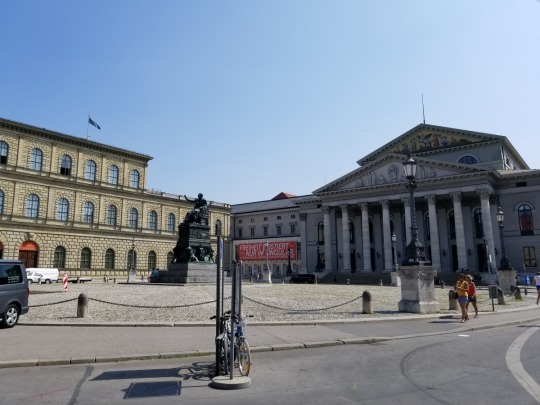
Retracing our steps from the previous day, we saw the Munich National Theater and Royal Residence. We also learned one of our favorite facts of the entire trip--right up there with Col. Shrapnel in Gibraltar.
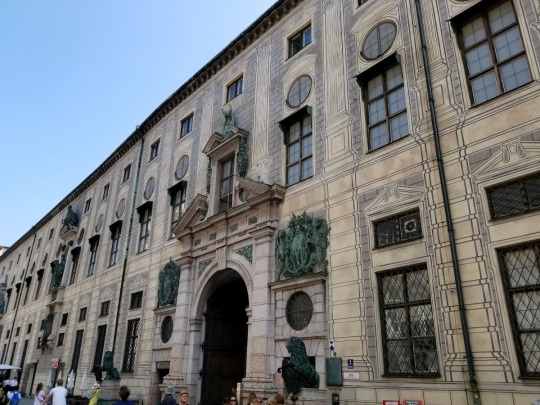
A long section of the Residence's outer walls are flat with paintings of intricate architectural embellishments. Jessica and I had seen similar designs throughout Europe and had just assumed the day before that this was done out of a similar aesthetic style. But that's not it at all.
After the almost total destruction of central Munich during the WWII, the people of Munich were largely left to rebuild their city on their own. I had always assumed that this had been covered by Marshall Plan--an American program that lent billions of dollars to rebuild Germany and the rest of Western Europe after the war. But the Marshall Plan funds were earmarked for rebuilding Germany's industry and commerce, not its heritage. The rebuilding of all the historic structures in Munich was done with what little money the locals could put together themselves.
They did a fantastic job, but there was only so much they could do. And the Residence, with its extraordinarily ornamented architecture, was simply beyond their means. So the people of Munich did the next best thing: they painted the walls to show what the building would have looked like if they had been able to rebuild it the way it actually was.
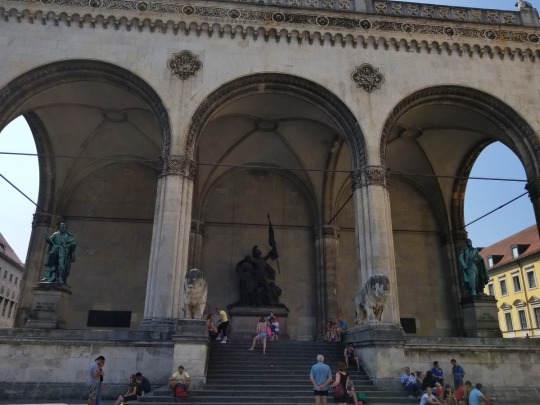
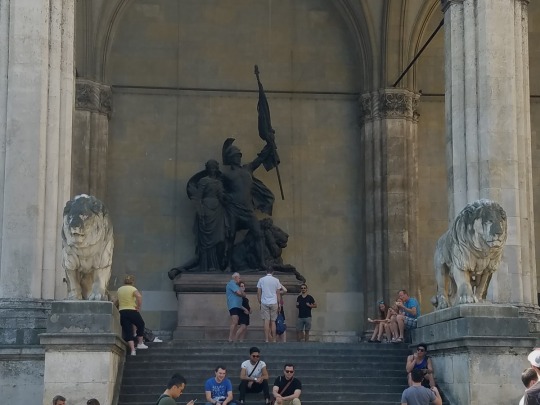
Our guide also pointed out the statue-filled loggia and confirmed that it was inspired by the one in Florence. He also pointed out the two lion statues flanking the stairs leading into it. The loggia is directly between the Residence and the Theatrine Church, and the two lions were meant to represent the co-equal powers of church and state in Bavaria.


Turning back into the Old Town, we headed over to the Hofbrauhaus, the largest and most famous beer hall in Munich--as well as one of the oldest. It can seat 1,300 people at once, but for the first 250 years of its existence it was the private property of the Bavarian nobility and closed to the general public. Since 1828, however, locals and tourists alike have been filling its benches and drinking beer by the liter.
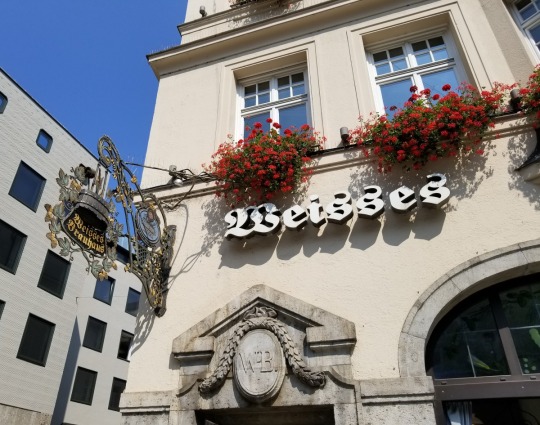
When Jessica mentioned that the main beers she enjoyed were wheat beers (hefeweizen or weissbier in Germany), our guide made sure to point out the nearby Schneider Weisse beer hall, where an unparalleled variety of weissebiers are on tap. There are seven different weissbiers in their main line, labelled "Tap 1" through "Tap 7," plus a further selection of seasonal and special-release weissebiers on tap at any given time. All are made by the family-owned Schneider & Son brewery in the nearby city of Kelheim.
Jessica's interest was thoroughly piqued. I had never particularly enjoyed wheat beers before, but I was willing to give it a try. We eventually did try it, and it was fantastic, but that's a story for a future post.
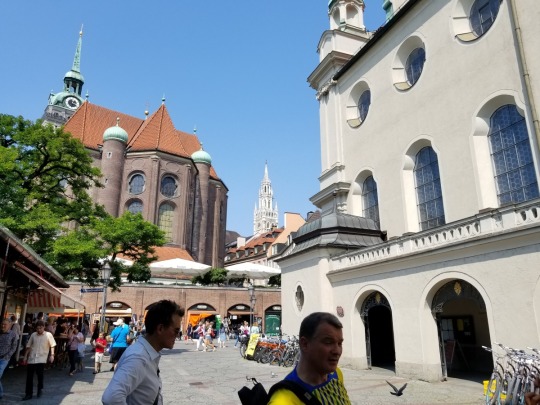
Our last stop was the Viktualienmarkt, a huge open-air food market centered around a massive beer garden. We learned that the beer garden is co-owned by the six Munich breweries, and they take turns so that all six make the same amount of profit. The current brand on tap was Spaten, which is generally considered to be the least-best of the bunch.
We also learned about Bavaria's beer garden culture. Before refrigeration was invented, beer kegs were stored in underground cellars to keep them cool, and trees were planted above the cellars for even more insulation. People soon realized that cool beer and shady trees make a perfect combination in the summer, so they started showing up at the breweries to drink beer and eat packed lunches.
When you visit the Viktualienmarkt or any other traditional beer garden, you will notice a mixture of tables with and without tablecloths. The tables with tablecloths are for traditional table service. You sit down and wait to be given a menu. But the tables without tablecloths are for the traditional picnic experience. You can get a group of friends, wander the market picking out tasty things to eat, then sit down at an unoccupied table and order a cool beer to wash it all down.
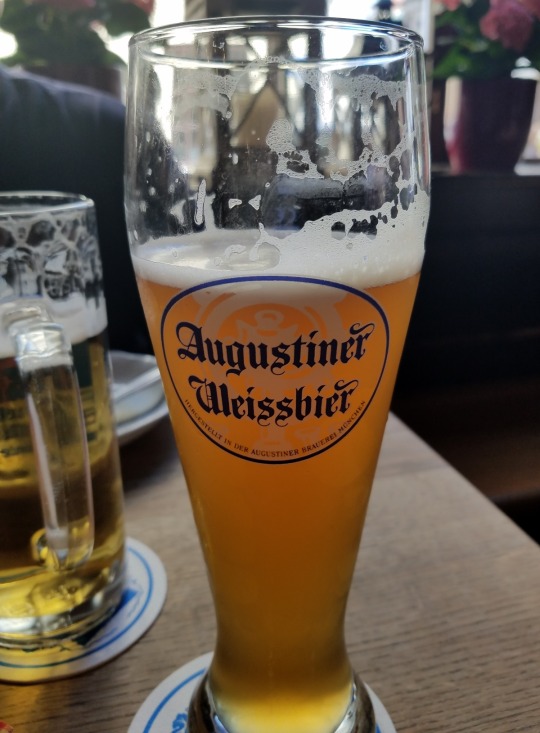
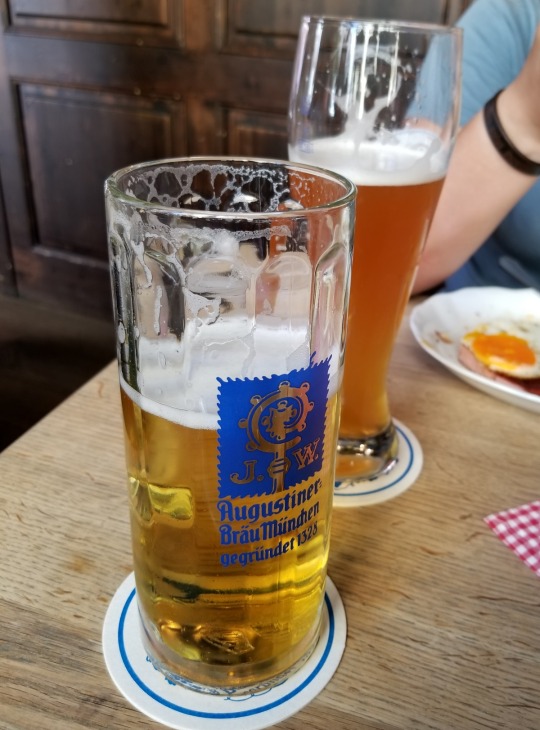
After the tour was over, went back to the Hofbrauhaus and had an excellent lunch at the nearby Augustiner restaurant. While Hofbrau is the most internationally famous Munich brewery, Augustiner is the oldest and most popular among native Münchners. While we never had a bad beer in Munich, we'll go along with the consensus that Augustiner is probably the best of the bunch. Which is sad, because they don't export their beer. It's hard to find it even in other parts of Germany.
I had their helles pale lager, and Jessica had their weissbeir. Both were top-notch.
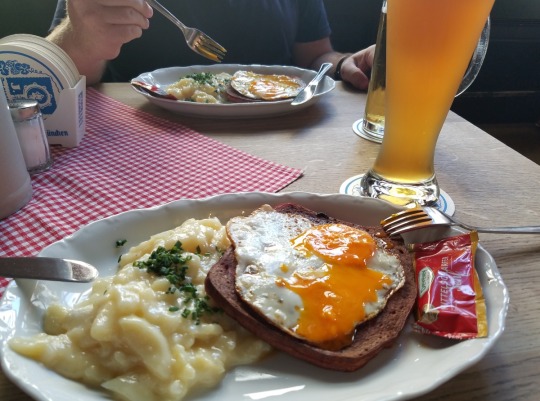
For the food portion of our lunch, we each enjoyed the beer garden staple of liberkäse--a mixed-meat sausage similar to bologna, baked into a loaf and cut into thick slices--pan fried and served under a fried egg. It also came with Bavarian potato salad, which is very different from American potato salad. It is thin and a little vinegary, but light and refreshing on a warm day.
We struck up a nice long conversation with an American guy at the next table who was doing his own extended European trip. I also took the opportunity to run to the bathroom and fix my shirt.
After lunch, we strolled around the shopping area and found a lot of stores selling cute if touristy Bavarian souvenirs. I found a nice stoneware mug that I really liked, but I decided to hold off and think about it for a bit. There was also a nice stationery store where I was severely tempted to buy a bottle of limited-edition Mont Blanc fountain pen ink that was on sale for half the price it is in the US. I didn't need it, though, and I wasn't eager to add a heavy glass bottle to my pack. Plus, I already had my sights set on some bottled inks that were waiting for me down the road in the Netherlands.
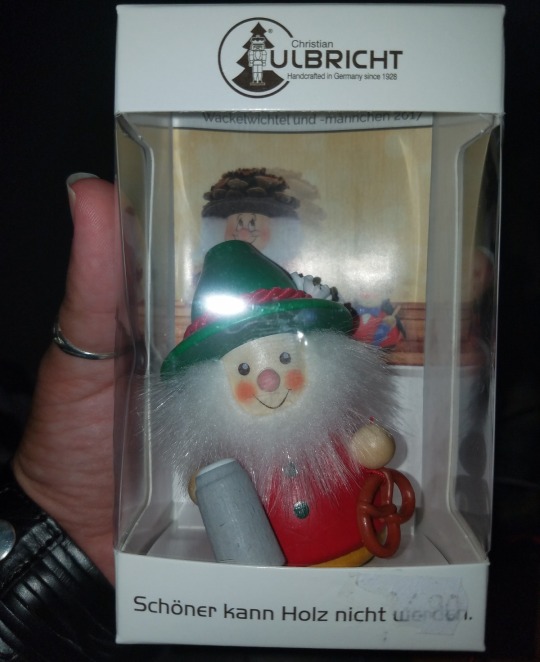
Jessica had fun too. She found a new friend at one of the aforementioned Bavarian souvenir shops, and we also found a whisky store specializing in fine Scotch. It seems almost heretical to sell Scotch in this mecca of beer, but we couldn’t resist. Jessica ended up buying a bottle of the Little Bay she’d enjoyed so much in Oban.
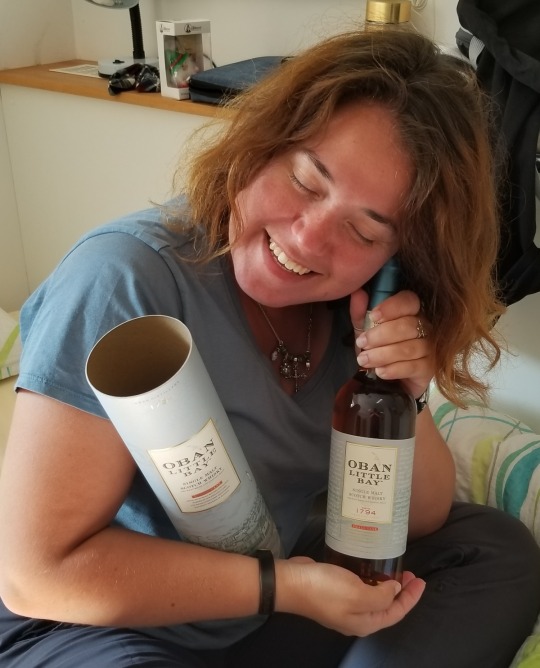
Don't worry, though--we never drank Scotch instead of German beer or wine, just in addition to it.
Yes, there was quite a lot of drinking that got done during this week, and we may have gone to bed toasted more times than not. But that didn't stop us from seeing and enjoying a ton of what Bavaria had to offer--including some sites that were truly sobering.
Next Post: Neuschwanstein (and the story of Mad King Ludwig)
Last Post: Salzburg & Berchtesgaden
1 note
·
View note
Text
Birmingham, Alabama
For my next trip... I’m taking a three week road trip through the American South to some parts familiar and others unknown. My trip began in a part unknown (to me anyway): Birmingham, Alabama, a city perhaps best remembered for its brutal opposition to blacks’ civil rights in the 1950s and 60s. I’ve heard good things about it since, but the past seemed like a good place to begin.
I started my first day at the cute Red Dog cafe, the kind of place filled with millennials and MacBooks that you can find in gentrified neighborhoods the world over. While this globalized hipster culture is somewhat lamentable, it’s reassuring as well and a sign of Birmingham’s economic progress. From there I headed to the Birmingham Civil Rights Institute. It’s in an historically very significant area. The neighborhood was a black exclusionary zone (one of the few areas of the city where blacks could live, work and own property and businesses). It’s between the Gaston motel (a black-owned motel that became a headquarters for civil rights leaders) and the 16th Street Baptist Church, a popular meeting place for the movement made infamous when a bomb there killed four young girls in 1963. And across the street is Kelly Ingram park, the site of many marches and protests, including a youth-led one where the police and fire department set dogs and high-pressure water houses on hundreds of adults and children.
The museum starts with a short film describing the city’s history. Interestingly Birmingham was founded after slavery, in 1871, as an iron producing town. It grew and prospered quickly, largely on the backs of black labor who were given the worst jobs for a pittance. And despite having never known slavery, the city became renown as one of the strictest and brutalist enforcers of segregation. The next few displays depict life under Jim Crow and some truly stomach-churning artifacts of black stereotypes and white supremacy. It then shifts to the long struggle to end segregation and win the vote and equal rights. It’s a familiar story but the resonance is so local here. As I’ve learned about the civil rights struggle throughout my life, I never really put together how much of the most intense fighting happened in just the one small part of the South. Rosa Parks and the bus boycott in nearby Montgomery. Dr King’s Birmingham home bombing and his famous letter from the local jail. Governor Wallace who won election-- and even carried five Southern states during his 1968 presidential campaign-- with his promise of “Segregation now, segregation tomorrow, segregation forever”. Police beating up peaceful marchers in nearby Selma. The 16th Street Baptist Church bombing. The city’s Police Chief, Bull Connor, and his notorious attack dogs and water cannons. Freedom Riders being beaten and killed across the state. Of course people fought for civil rights all over the South (and later all over the country), but Alabama-- and especially Birmingham-- were the epicenter. All the familiar speeches, history, newsreels and photos felt devastatingly real seeing them there.
The problem that all history museums face is deciding when and how to end because history never ends. In this case, by the late 60s the segregationists started to accept defeat (Wallace’s campaign notwithstanding), and the action moved away from Birmingham and Alabama. The Civil Rights Movement itself splintered into countless factions espousing varying goals and methods, the chaos of which helped spur a backlash and the election of Nixon by his “silent majority.” The museum kind of rushes through the late 60s and ultimately ends by celebrating the 1979 election of Birmingham’s first black mayor, Richard Arrington, Jr (depicted with an entirely pointless recreation of the mayor’s office). While that is an achievement to be lauded and the curators probably felt compelled to leave visitors feeling uplifted, it parallels (and foreshadows) the “problem solved” mentality that followed Obama’s election. Gaining legal equality was a first step (or second, after ending slavery), but I think it would have been powerful for the museum to highlight some of the many ways racism still persists: in politics, government, urban design, economics, business, education and health, not to mention in many hearts and minds. (Arrington’s election was followed three years later by Wallace’s re-election as governor to a fourth term.) A final, more uplifting display could depict the ways that blacks’ civil rights struggles inspired others like women, gays, Native Americans and immigrants. (There actually are some colorful displays honoring a few civil rights causes around the world, but they seem more random than anything.)
After seeing the museum I walked over to the church (which was closed) and through the park, which has several haunting sculptures depicting the violent crackdown on young protestors there. It’s all so calm and quiet now, it’s almost hard to believe what was happening there in my parents’ living memory.
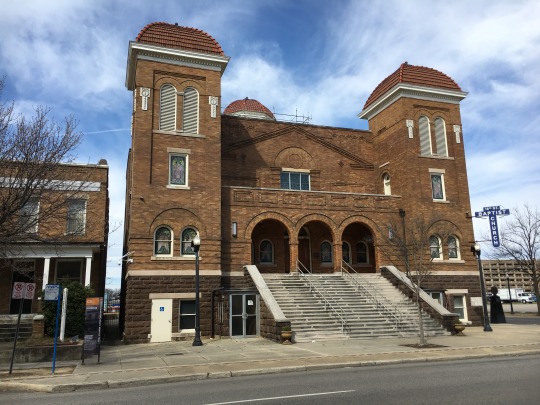
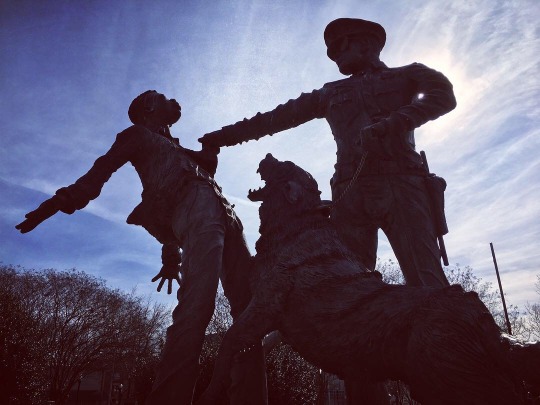
(For the surprising backstory on the above statue and the photo on which it’s based, check out this podcast of Revisionist History.)
From there I went to the Birmingham Museum of Art. I actually just wanted to see the sculpture garden which had a good sampling of thoughtful and whimsical works. After a quick lunch stop at a middle eastern place (which still managed to be brown, fried and greasy since this is the South), I went up to Vulcan Park. It’s the site of a massive statue of Vulcan, the god of fire, and it’s the largest cast-iron statue in the world. The museum next door is an ode to Birmingham and iron, the metal that built the city literally and figuratively; iron mining and production was the dominant industry for the city’s first 100 years. While I liked learning some of the city history and seeing the old photos, the generally unqualified enthusiasm raised doubts about how fairly the story was being told. It was at least a stark contrast to the unflinching, ugly history lesson I experienced earlier.
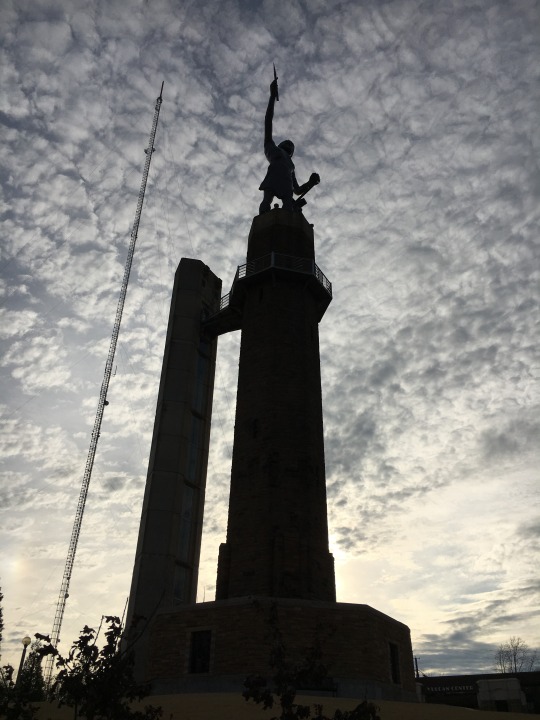
That evening I visited a couple gay bars, Chapel (housed in a former church and up until a few months ago, a leather bar named Spike’s) and Al’s. Chapel’s crowd was thin but admirably diverse. They felt like the high school outcasts who had all banded together. And the drag show (featuring queens and kings in equal number) was cute but decidedly low-rent DIY. The host was wearing a Star Trek costume.... Al’s was the opposite, the popular clique in high school. It looks like your standard pop-fueled gay dance bar, and their drag show was much more polished. (Apparently Birmingham gay bars are all about drag shows.) The star that night was Trinity “The Tuck” Taylor who grew up in Birmingham and is now in the final four on RuPaul’s Drag Race. So that was probably exciting to anyone who cares.
On Saturday I slept too late again, but eventually got up and made my way to brunch at Five in the hip little Southside area (near the gay bars). I then drove to Sloss Furnace, a massive dormant ironworks, originally built in the 1880s. Much of the machinery and infrastructure is still in place (tho rusted away), and you can walk around and explore. It’s captivating, like walking around an ancient ruin, but one which was still in use only 50 years ago. It’s a lot to think about as you wander through the deserted behemoth: how massive this operation once was, how many resources it sucked up, how much iron it produced, how many people died working it, how much it grew Birmingham’s economy and how it’s now literally a shell of its former self just 150 years after it was built. Along with the Civil Rights Museum, Sloss is another reminder to Birmingham just how quick and difficult change can be.

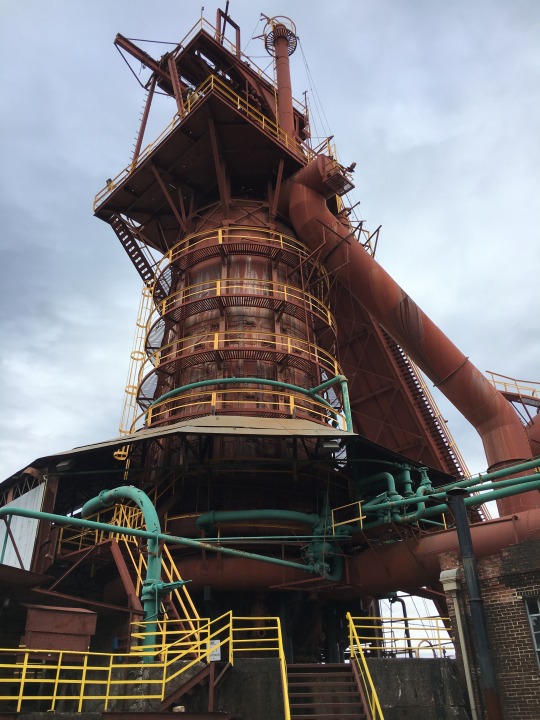
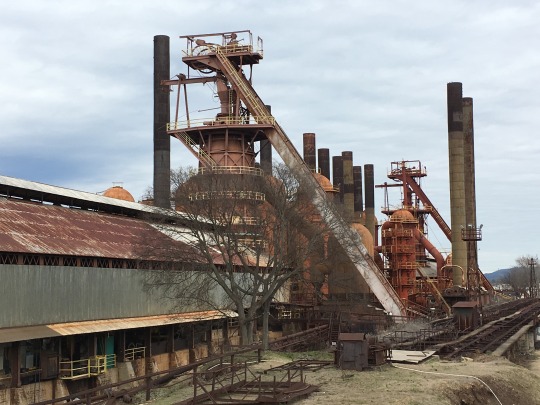
The mini-museum at Sloss unfortunately is not so inspiring. Obviously it’s very pro-iron, like the one at Vulcan Park, but its white-washing of history is both comical and offensive. There’s no mention of the environmental impact. The factory towns sound like great places to live (they were not). The (mostly immigrant and black) workers are described as pioneers seizing opportunity, not exploited labor. The only mention of the racist division of labor was an admission that the factory had separate baseball teams for whites and blacks (but supposedly they would all go to each others’ games anyway so it was all good). In one confused sentence we learn that Sloss had a “decent safety record” but injuries and deaths were also very common. In fact we learn the best protection a worker could get was from having good coworkers (not from, say, adequate gear, precautions and risk reduction, all of which cost money). And, by the way, the state’s whole iron industry went into decline after the passage of the Clean Air Act of 1970 and the removal of tariffs on foreign iron. (No mention of how these events impacted the quality of air or the cost of iron to builders and consumers.) The ingenuity, hard work and rapid success of the city’s iron industry is very impressive but it’s worth remembering the cost.
For dinner Saturday night I went to Hot & Hot Fish Club, one of the city’s finest. It was delicious but didn’t seem especially distinctive. I’m not sure why it’s on so many must-do lists. I figured some sleep would do me good so I stayed in that night.
For my last day I visited the popular Five Points South and Homewood areas. Five Points is (or was) a hip area (it’s near the University), but that’s hard to see, especially on Sunday when most businesses are closed. It has some lovely Spanish Revival and Art Deco buildings, but it’s very small and a bit run-down. Homewood is better kept-up, kind of like a quaint 1950s main-street but with yuppie boutiques selling linens and children’s toys. It has a lot more shops and restaurants, and I found a good lunch at Real & Rosemary and a friendly coffee at Henry’s.
After that I visited the Botanical Gardens. As one would expect in early February, not much was in bloom, but the gardens were still very nice. They’re sprawling and serene, with a good mixture of design styles. Half the gardens are built into a hillside, and the terraced paths offer ample opportunities to get lost and discover. And of course there are lots of gazebos because this is the South. The evening was chill. I had dinner at a Southern burger ‘n beer chain called Jack’s (pretty good but small burger) and stopped at Chapel for a drink. The tiny crowd was once again eclectic and this time watching the Grammys.
Birmingham is definitely a small city in Alabama (especially for the gays). I sensed racial and socioeconomic stresses beneath the surface-- or rather around the edges. (I spent my time in the center between downtown and some very fancy neighborhoods, and I hardly saw any black people although they are 75% of the population here.) And yet it has a hard-to-define appeal. By all logic it should be a cultural backwater, but it’s not. Despite its origins as essentially a factory town for iron producers, its deeply disturbing racial history, and its on-going racial and socioeconomic divides, it seems determined to persist, to accept its past and celebrate the openness and diversity that came out of it. In the city’s early days, its rapid growth and economic success earned it the nickname “The Magic City.” During the Civil Rights era, it was re-dubbed “The Tragic City.” But Birmingham’s drive to prosper despite-- and because of-- its past has brought back much of the magic.
0 notes
Text
June 30, 2019
Yesterday was a busy, exhausting day. But I feel good about it. Mostly.
Friday night, around 2am, there were fire trucks etc all over my building. At first I thought it was a car crash, because those happen here all the time. But I got curious and looked out the window and couldn’t see any car. Plus, then I started hearing things in the hall. Made me wonder if they were all up in our building. But no alarms were off. So then I started wondering if there was something wrong with the alarm (not likely) or that it was something that they might evacuate certain floors rather than the whole building. I mean, I did keep hearing things in the hall. I actually got in some clothes and prepared for me and the cat to go. Nothing. I had stayed inside b/c I didn’t want to get in the way, but finally the tension/curiousity got the best of me. Didn’t see anyone, didn’t want to go in the stairwell in case I’d be in the way. Ended up having a conversation with another lady who opened her door. Came back into my apartment, and they’d all left. That whole situation was about an hour. But I couldn’t sleep for a couple hours after that.
So, I slept in yesterday morning. Decided to go out for a healthy-ish breakfast. Went to eye hop. Disappointing. What I got served was a lazy man’s edition of what was in the menu. And, while I thought I was doing good with 650 calories, it turns out that’s a shit ton of points! Made me do some thinking. They say the average American diet is 2k calories a day. I forget sometimes that that should be 1600 cal for women. And that average doesn’t mean healthy either (since I’m confident I eat over the average). So, anyway thinking 2000/3 meals is 650-ish, I’m doing well. But really, after all my thinking, I’m thinking if I’m going to eye ball, a healthy meal is probably around 350 calories. Because depending on what those 350 are, they’re more or less points.
Then I went and played racquetball. I was hot as hell and had no water, so I only played about 40 minutes. Went to get coffee, and one of my barista people gave me a free one. While we were talking, I found out her sister had died in March or April. Her mother had died only a few months before, so she was pretty messed up. I wish I’d known, but I wasn’t going there very often, and when we were both there, she was always super busy. On my way from that bucks, I stopped at the community center and signed up for a lap swim membership! And I finally stopped at that gay bar that’s in my neck of the woods. They were open, and it’s really nice inside. I’m gonna go. Eventually. Thought about going last night for a drag show but didn’t. It means a lot to me about that place, because I live in a primarily black area, and the queer community has a tougher time when it intersects with the black community, so this bar, being there for decades? was really an oasis for black queer people at an even more intolerant time than we live in today. I got a little misty-eyed thinking about it. Came home and tried to nap. Didn’t.
Decided I needed to figure out some other things to be productive, b/c I needed to go out again to another bucks to get my 3 days in a row deal. Decided to get a bit of shopping done and maybe treat myself to a pedicure. My feet are always tore up and I think of a pedi but never do b/c they’re expensive. And I’ve talked about it for about 2 years now lol. So, I did that. I think it’s been over 10 years since I’ve had one, and I’ve only had a handful over my life. I’m so grateful that there was a really nice younger woman sitting next to me. She had to translate and give me remedial pedicure lessons, so I could make my choices. I let her pick out my nail polish. It’s a really nice shade of peach-ish/hot pink. Not too wild, and not too conservative. The girl said my feet were in great condition considering I hadn’t had a pedicure in a decade. That’s something I guess? I got a bit of a massage from the chair which was a bonus, and finally did some reading in a book I’ve started a few times.
Then I went to wall smart. Usually, I have a bit of a running list in my head of what I need/ want when I get paid. But this time, I really had to think. I got a bunch of stuff that are always on the bottom of my list, but forgot the one thing I decided to treat myself to - sheet corner fasteners. Oh well. Next month perhaps.
One thing on the list was to check for some shorts and/or tank tops so I can try to get some more color. Dude. I asked a couple of ladies (one was on the dressing rooms, the other may work there but wasn’t on the clock if she does) their opinion on one thing, which turned into them helping me with half my options. Which turned into me trying on, for the first time in my life, leggings. And they didn’t look bad on me! At least compared to a couple other things I tried on lol. So yeah, I bought leggings. It’s crazy. And, I found a tank-ish shirt style I liked, and got it in a size smaller than I expected! And they were really nice and telling me I need to be more confident in my body. And anyway, one of them asked to exchange numbers with me and said we were gonna be friends. We’ll see. But it’s always nice. I can’t help wondering if she felt sorry for my lack of confidence in the clothes thing; if she wants to like ‘mentor’ me. But she was super nice and I’ll take it!
I picked up some church is chicken (eh). Watched some little lies big (which I’d binged Friday night by accident), and went to bed. Oh also, I deleted the phone game I’ve been addicted to the last few weeks. It’s pointless, if I think about it. There’s no ‘end’. Nothing to win. Just endless achievements combined with endlessly increasing hardness. I’m kind of proud of myself.
Now today the question is how productive I’ll be. I need to apply for some jobs. Check out the status of that work transport thing. I really want to do some cleaning. I’d like to do racquetball 2 days in a row. And maybe get my swim on. Might need to return some of those clothes too - with the other stuff I got, like cat food and window wiper fluid, I spent $169.69! I did find a pair of $7 shoes that I like despite the fact that I’m surprised I like them. No open-toed sandals though lol.
Hmm. i’m looking at my feet and she didn’t take all the callous buildup off. I’m surprised bc she used what looked like a damn cheese grater, plus a pumice stone type thingy. And a scrub. But I guess it’s probably a good thing. Technically, that stuff is a bit of protection.
0 notes